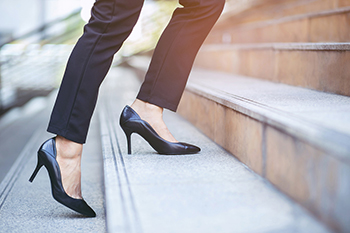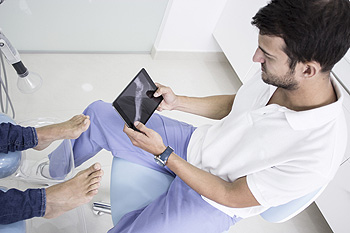
High heels, while undoubtedly stylish, come with a hidden price tag that affects our feet, which are the foundation of our body. These chic yet often uncomfortable footwear choices can lead to a cascade of issues. The elevated heel forces the body's weight forward, disrupting the natural alignment of the spine, possibly causing lower back pain. Additionally, toes are crammed into tight spaces, and may lead to deformities such as bunions and hammertoes. The lack of proper arch support strains the feet's ligaments and tendons, contributing to plantar fasciitis and Achilles tendonitis. Prolonged wear can result in shortened calf muscles, impacting overall gait and stability. Recognizing how wearing high heels can negatively affect the feet may cause an individual to try different footwear. If you would like more information about the effects high heels can have on the feet, it is suggested that you speak with a podiatrist who can address any questions or concerns you may have.
High heels have a history of causing foot and ankle problems. If you have any concerns about your feet or ankles, contact one of our podiatrists from Riznyk Podiatry. Our doctors can provide the care you need to keep you pain-free and on your feet.
Effects of High Heels on the Feet
High heels are popular shoes among women because of their many styles and societal appeal. Despite this, high heels can still cause many health problems if worn too frequently.
Which Parts of My Body Will Be Affected by High Heels?
What Kinds of Foot Problems Can Develop from Wearing High Heels?
How Can I Still Wear High Heels and Maintain Foot Health?
If you want to wear high heeled shoes, make sure that you are not wearing them every day, as this will help prevent long term physical problems. Try wearing thicker heels as opposed to stilettos to distribute weight more evenly across the feet. Always make sure you are wearing the proper shoes for the right occasion, such as sneakers for exercising. If you walk to work, try carrying your heels with you and changing into them once you arrive at work. Adding inserts to your heels can help cushion your feet and absorb shock. Full foot inserts or metatarsal pads are available.
If you have any questions please feel free to contact our office located in Orchard Park, NY . We offer the newest diagnostic and treatment technologies for all your foot and ankle needs.

Podiatry is a specialized branch of medical care that focuses on diagnosing and treating foot, ankle, and lower limb conditions. Podiatrists, often referred to as foot doctors, play a vital role in maintaining overall mobility and well-being. These healthcare professionals are trained to address a wide range of foot-related issues, ranging from minor ailments to complex conditions. To become a podiatrist, one typically needs to complete a Doctor of Podiatric Medicine (DPM) degree, which involves rigorous education and clinical training. This encompasses a comprehensive study of anatomy, physiology, biomechanics, and surgical techniques specific to the lower extremities. Through their extensive training, podiatrists become skilled experts dedicated to preserving and improving the function and health of their patient's feet and ankles. If you are interested in pursuing podiatry as a career choice, it is suggested that you visit this type of doctor who can answer any questions you may have.
If you are dealing with pain in your feet and ankles, you may want to seek help from a podiatrist. Feel free to contact one of our podiatrists from Riznyk Podiatry. Our doctors can provide the care you need to keep you pain-free and on your feet.
What Is a Podiatrist?
A podiatrist is a doctor of podiatric medicine who diagnoses and treats conditions of the foot, ankle, and related structures of the leg. Your podiatrist may specialize in a certain field such as sports medicine, wound care, pediatrics, and diabetic care. Podiatrists have the ability to become board certified through training, clinical experience, and then taking an exam.
What Do Podiatrists Do?
On a daily basis, a podiatrist may perform the following activities:
It is very important that you take care of your feet. It’s easy to take having healthy feet for granted, however foot problems tend to be among the most common health conditions. Podiatrists can help diagnose and treat a variety of feet related conditions, so it is crucial that you visit one if you need assistance.
If you have any questions please feel free to contact our office located in Orchard Park, NY . We offer the newest diagnostic and treatment technologies for all your foot and ankle needs.

Plantar warts are benign skin growths that appear on the soles of the feet caused by the human papillomavirus. These warts can be painful and discomforting, often characterized by small, grainy bumps with black dots in the center. The virus enters the skin through small cuts or abrasions and thrive in warm, moist environments like public showers and swimming pools. While plantar warts are generally harmless, they can be stubborn and challenging to eliminate without proper treatment. Over-the-counter remedies such as salicylic acid or freezing solutions may provide some relief but professional interventions that can include cryotherapy, laser therapy, or surgical removal may be necessary for complete eradication. To prevent plantar warts, it's crucial to maintain good foot hygiene, wear protective footwear in public areas, and avoid sharing personal items with others. If you have developed a plantar wart, it is suggested that you visit a podiatrist who can offer effective treatment options.
Plantar warts can be very uncomfortable. If you need your feet checked, contact one of our podiatrists from Riznyk Podiatry. Our doctors will assist you with all of your foot and ankle needs.
About Plantar Warts
Plantar warts are the result of HPV, or human papillomavirus, getting into open wounds on the feet. They are mostly found on the heels or balls of the feet.
While plantar warts are generally harmless, those experiencing excessive pain or those suffering from diabetes or a compromised immune system require immediate medical care. Plantar warts are easily diagnosed, usually through scraping off a bit of rough skin or by getting a biopsy.
Symptoms
Treatment
To help prevent developing plantar warts, avoid walking barefoot over abrasive surfaces that can cause cuts or wounds for HPV to get into. Avoiding direct contact with other warts, as well as not picking or rubbing existing warts, can help prevent the further spread of plantar warts. However, if you think you have developed plantar warts, speak to your podiatrist. He or she can diagnose the warts on your feet and recommend the appropriate treatment options.
If you have any questions please feel free to contact our office located in Orchard Park, NY . We offer the newest diagnostic and treatment technologies for all your foot and ankle needs.

Cuboid syndrome, also known as cuboid subluxation or lateral plantar neuritis, is a relatively rare and painful condition that affects the cuboid bone in the foot. The cuboid bone is a cube-shaped bone located on the outer side of the foot, forming a vital part of the foot's structure and stability. Cuboid syndrome can be caused by various reasons. The cuboid bone can shift out of alignment by rolling or twisting the ankle or it can happen from overuse or repetitive stress. This is a common condition among ballet dancers, as a result of this type of dance style. Having poor foot biomechanics such as flat feet, overpronation, or other foot abnormalities also can disrupt the cuboid's positioning. Wearing shoes that do not fit properly can contribute to developing cuboid syndrome as well. Common symptoms include pain on the lateral side of the foot, difficulty in walking, and discomfort while bearing weight. Early diagnosis and appropriate treatment can aid in resolving cuboid syndrome effectively. If you have pain on the outside of your foot, it is suggested that you consult with a podiatrist for an accurate diagnosis and treatment options.
Cuboid syndrome, also known as cuboid subluxation, occurs when the joints and ligaments near the cuboid bone in the foot become torn. If you have cuboid syndrome, consult with one of our podiatrists from Riznyk Podiatry. Our doctors will assess your condition and provide you with quality foot and ankle treatment.
Cuboid syndrome is a common cause of lateral foot pain, which is pain on the outside of the foot. The condition may happen suddenly due to an ankle sprain, or it may develop slowly overtime from repetitive tension through the bone and surrounding structures.
Causes
The most common causes of cuboid syndrome include:
Symptoms
A common symptom of cuboid syndrome is pain along the outside of the foot which can be felt in the ankle and toes. This pain may create walking difficulties and may cause those with the condition to walk with a limp.
Diagnosis
Diagnosis of cuboid syndrome is often difficult, and it is often misdiagnosed. X-rays, MRIs and CT scans often fail to properly show the cuboid subluxation. Although there isn’t a specific test used to diagnose cuboid syndrome, your podiatrist will usually check if pain is felt while pressing firmly on the cuboid bone of your foot.
Treatment
Just as the range of causes varies widely, so do treatments. Some more common treatments are ice therapy, rest, exercise, taping, and orthotics.
If you have any questions, please feel free to contact our office located in Orchard Park, NY . We offer the newest diagnostic and treatment technologies for all your foot care needs.

The strong band of tissue that runs from the calf muscles to the heel bone is known as the Achilles tendon. When this tendon is overused, which is frequent among runners, dancers, and other athletes, it can become inflamed and extremely painful. This condition is called Achilles tendinopathy. The top cause of Achilles tendinopathy is overuse, which tears or stretches the tendon and causes inflammation. Other causes include certain types of arthritis, flat feet, and overpronation. In addition, wearing shoes that lack adequate support, being overweight, and taking certain antibiotics may increase the likelihood of developing Achilles tendinopathy. There are a number of treatments available for Achilles tendinopathy, but healing time depends on the severity of the injury. In some cases, surgery is required. There are several ways to prevent tendinopathy, including stretching exercises and warmup and cool-down routines. Wearing proper footwear is another way to help prevent this injury. For more information, it is suggested that you consult a podiatrist.
Achilles tendon injuries need immediate attention to avoid future complications. If you have any concerns, contact one of our podiatrists of Riznyk Podiatry. Our doctors can provide the care you need to keep you pain-free and on your feet.
What Is the Achilles Tendon?
The Achilles tendon is a tendon that connects the lower leg muscles and calf to the heel of the foot. It is the strongest tendon in the human body and is essential for making movement possible. Because this tendon is such an integral part of the body, any injuries to it can create immense difficulties and should immediately be presented to a doctor.
What Are the Symptoms of an Achilles Tendon Injury?
There are various types of injuries that can affect the Achilles tendon. The two most common injuries are Achilles tendinitis and ruptures of the tendon.
Achilles Tendinitis Symptoms
Rupture Symptoms
Treatment and Prevention
Achilles tendon injuries are diagnosed by a thorough physical evaluation, which can include an MRI. Treatment involves rest, physical therapy, and in some cases, surgery. However, various preventative measures can be taken to avoid these injuries, such as:
If you have any questions please feel free to contact our office located in Orchard Park, NY . We offer the newest diagnostic tools and technology to treat your foot and ankle needs.